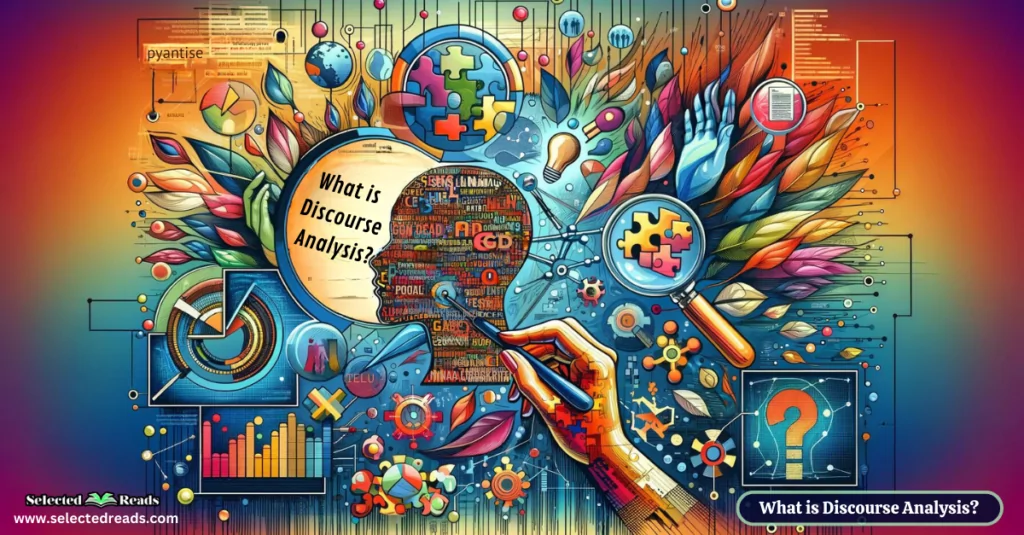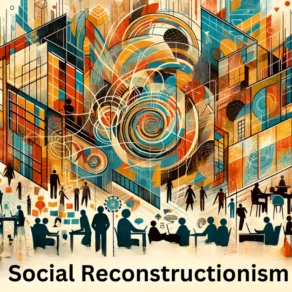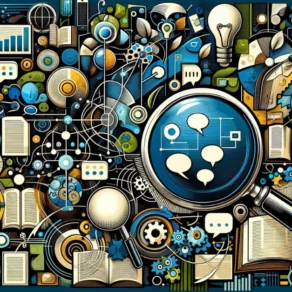In the expansive universe of language and communication, discourse analysis represents a critical intersection between words, their meanings, and the societal structures that shape them. At this juncture, I find myself returning again and again, intrigued by the profound insights and subtleties it offers. This fascination is not new, nor is it superficial.
From my doctoral thesis to numerous research papers, discourse analysis – and more specifically, critical discourse analysis – has been an invaluable tool and a guiding beacon in my academic journey.
I believe that our words, how we say them, and where they are situated, provide an underlying narration to the world as we know it. These narratives, however, often go unspoken or unseen. In my quest for knowledge and understanding, I have harnessed the power of discourse analysis to shine a light on these narratives, to reveal what is often hidden in plain sight.
For those unacquainted with the term, discourse analysis delves into the study of language beyond mere sentences, extending to the broader social and political contexts. Critical discourse analysis goes a step further, scrutinizing these structures to uncover power dynamics, inequalities, and ideologies often masked beneath the veil of language. My work has seen me employ these techniques in a host of scenarios, from the refined halls of academia to the ever-evolving landscape of social issues.
The goal of this blog post is to familiarize you with the concept of discourse analysis. It’s about offering you an insight into a methodology that has been fundamental to my own research, and indeed, to a vast array of studies in linguistics, social sciences, and beyond.
This post is intended as a starting point, a stepping stone into the riveting river of discourse analysis. We will begin by laying the groundwork, providing you with the essential definitions. This foundational understanding will serve as your springboard, from which you can dive deeper into the complex and compelling aspects of discourse analysis.
What is discourse Analysis?
Discourse analysis is an interdisciplinary area of study that takes discourse as an analytical unit in its study of social phenomena. The study of discourse first originated in the fields of linguistics, philosophy and anthropology.
Later on, especially with the linguistic turn that marked the second half of the last century, discourse analysis extended to various disciplines including social psychology, communication, cognitive psychology, artificial intelligence, among others.
Given its interdisciplinary nature, the definition of discourse analysis varies from one discipline to the other and its meaning is strictly associated with the purposes for which it is used. As Schiffrin et al. (2001) noted, discourse and discourse analysis have different meanings to scholars in different fields. For many, particularly linguists, ‘discourse’ has generally been defined as anything ‘beyond the sentence’. For others (for example Fasold 1990,:65) the study of discourse is the study of language use. (p. 1)
All of these definitions, as Schiffrin argues, focus on discourse as a linguistic entity almost separated from the social intricacies surrounding it. In other words, this view of discourse is limited and linguistically deterministic to say the least.
For critical theorists and social constructivists, discourse is way more than mere linguistic symbols used arbitrarily to convey meaning. Discourse for them embeds relations of power and ideological structures.
In this sense discourse is a social practice that shapes and is shaped and constructed by linguistic and non linguistic practices. Also, critical theorists view discourse as a count name hence phrases such as discourse of power, discourse of xenophobia, discourse of hate, etc.
Therefore, a comprehensive definition of discourse should take into account these three categories: anything beyond the sentence, language use, and social practices. To learn more about discourse analysis, here is a collection of discourse analysis books I read during my graduate studies.
Approaches to Discourse Analysis
Discourse analysis embeds several approaches and methods of analysis. Some of these approaches, according to James Paul Gee (2010), analyze the content of language in use and others focus on grammar and syntactic structures. Gee distinguishes between Discourse with a capital D and discourse with a small d.
The earlier refers to the identities speakers create through the way they interact, behave, and communicate and the latter refers to what Gee called “language-in-use or stretches of language (like conversations or stories)”.
In her book Approaches to Discourse, Deborah Schiffrin outlines a number of approaches to discourse analysis including speech act theory, interactional sociolinguistics, the ethnography of communication, pragmatics, conversation analysis, variation analysis, and I add critical discourse analysis.
What is Critical Discourse Analysis?
As stated earlier, discourse is never neutral. It is inherently political and always communicates cultural, social, political, and ideological assumptions. Discourse is also an instrument of power control and as Kress (1982) contended, discourse is “inescapably ideologically structured” (p. 65).
With this in mind, critical discourse analysts seek to unravel the hidden relations of discourse to topics such as social justice, racism, inequalities, sexism, etc. The purpose is to expose these hidden relations and explain how the machinery of language works to reproduce and maintain these power relations.
Critical discourse analysis, therefore, is an analytic framework that is theoretically informed by insights from critical paradigms to knowledge construction including critical linguistics and critical theory.
CDA is both a theory and a method. A theory because it provides researcher with a theoretical lens through which to approach the study of social phenomena and as such it assumes a number of theoretical stances including that language is never neutral, that discourse is a social practice that constructs and is socially constructed, and that language is a site of ideological conflicts and power imbalances (Fairclough, 1989).
Critical discourse analysis are explicit about their epistemological and ontological positions and acknowledge that their analysis is subjectively shaped and part of it is what Widdowson called ‘exercise in interpretation’.
Related: What Is Critical Discourse Analysis? 20 Seminal Books
What is The Difference Between Discourse Analysis and Critical Discourse Analysis?
The difference between discourse analysis and critical discourse analysis is a point I discussed in detail in my doctoral dissertation. Both DA and CDA describe and interpret discursive acts, however, CDA goes a step further and tries to explain why social practices are the way they are and how we can intervene and transform these practices.
In other words, the work of CDA analysts is to intervene in the political and social world with the purpose of transforming it. The ultimate objective of CDA is to “create a world where people would not be discriminated against because of sex, colour, creed, age or social class.”(Coulthard and Coulthard,. 1996. P .4)
Approaches to Critical Discourse Analysis
There are various approaches to critical discourse analysis, each of which departs from a specific focus and makes use of a number of analytical tools to study the interrelation of language, power, knowledge, and ideology.
Some of these CDA approaches, according to Roger, include French discourse analysis pioneered by works of Michel Foucault (e.g., 1972) and Michel Pêcheux (e.g., 1975), sociolinguistic studies represented by works of Teun van Dijk (e.g., 1997) , social semiotics as manifested in the works of Robert Hodge and Gunther Kress (e.g., 1988) and the discourse historical approach as represented by the works of Ruth Wodak (e.g., 2001).
Final thoughts
Through the lens of discourse analysis, and CDA in particular, I’ve sought to dissect the complex interplay between language and power, to uncover the ideologies and inequalities that are often woven subtly into the fabric of our communication. It’s a method that has not only enriched my research but also offered profound insights into the dynamics of social issues and the construction of knowledge itself.
For those stepping into the realm of discourse analysis for the first time, or even for seasoned scholars, remember: this field offers a kaleidoscope through which to view the intricate patterns of language and society. Whether your interest is sparked by a curiosity about language’s role in social structures, or you’re seeking tools to dissect the layers of meaning that shape our perceptions and interactions, discourse analysis provides a robust framework for inquiry.
The distinction between discourse analysis and critical discourse analysis is particularly significant. While both approaches offer valuable lenses for exploring language in use, CDA delves deeper, aiming not just to describe but to understand and transform the socio-political contexts that language both reflects and influences. It’s an approach that carries with it the potential for real-world impact, offering pathways to challenge and change the discourses that underpin social injustice and inequality.
As we conclude, let this post serve not just as an introduction but as an invitation—to dive into the rich, complex waters of discourse analysis, to explore its various approaches, and to wield its insights as tools for understanding and perhaps even transforming the world around us. The books and methodologies discussed herein are but stepping stones into the vast river of discourse analysis, a starting point for your own exploration of the power of language and its role in the tapestry of human experience.
References
- Coulthard, R. & Coulthard, M.(eds.). (1996). Texts and practices: Readings in critical discourse analysis. Routledge.
- Faircough, N. (1989). Language and power. Longman.
- Fasold, R. (1990).Sociolinguistics of language. Basil Blackwell Inc.
- Foucault, M. (1969/1972). The archaeology of knowledge (S. Smith, Trans.). Pantheon Books
- Gee, P. (2010). An introduction to discourse analysis: Theory and method (3rd edition). Routledge.
- Hodge, R & Krees, G. (1988). Social semiotics. Polity.
- Pecheux, M.(1975). language, semantics and ideology. New York: St. Martin’s Press
- Kress, G. (1982). Discourses, texts, readers and the pro-nuclear arguments. In P. Chilton (ed.). Language and the nuclear arms debate: Nukespeak Today (pp. 65-87). Frances Pinter.
- Rogers, R., et al. (2005). Critical discourse analysis in education: A review of the literature. Review of Educational Research, 75(3), pp. 365-416.
- Schiffrin, D. (1994). Approaches to discourse. Blackwell Publishers.
- Schiffrin, D., Tannen, D, & Hamilton, H.E.(Eds.). The handbook of discourse analysis. Wiley-Blackwell.
- Van Dijk, T. (1997). Discourse as Social Interaction. SAGE Publications Ltd.
- Woodak, R.(2001). The discourse historical approach. In R. Wodak & M, Meyers(eds.). Methods of critical discourse analysis (pp.63-95). Sage.






